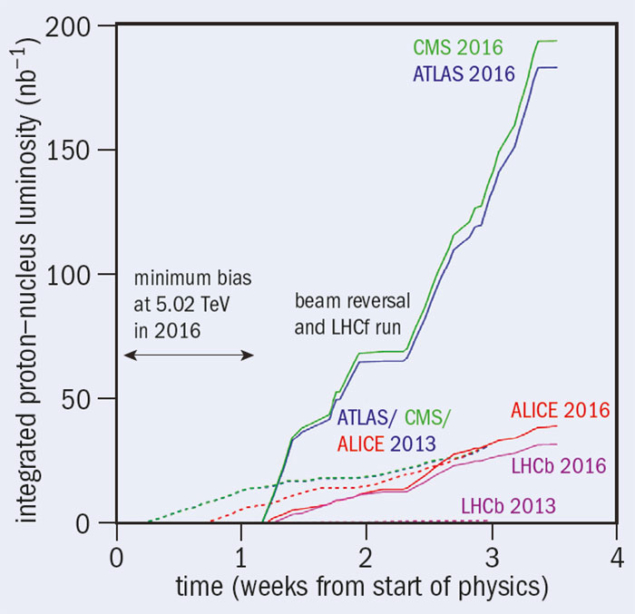

On 26 October, the LHC completed its 2016 proton–proton operations at a collision energy of 13 TeV, during which it exceeded the design value of the luminosity and broke many other records (CERN Courier December 2016 p5). As in most years, the machine was then reconfigured for a month-long heavy-ion run, devoted this year to colliding beams of protons (p) and lead nuclei (Pb). Following a feasibility test in 2012 and an initial month-long run in 2013, pPb collisions remain a novel mode of operation at the LHC. Despite this novelty, the LHC team was able to deliver enormous data sets to the experiments for the investigation of extreme nuclear matter during the 2016 run.
Asymmetric proton–nucleus collisions were originally seen as a means to disentangle cold from hot nuclear-matter effects studied in lead–lead collisions. Surprisingly, a more complex picture emerged following the pPb results of 2012 and 2013. For 2016, the LHC experiments requested a variety of apparently incompatible operating conditions, according to their diverse capabilities and physics programmes. Careful analysis of the beam physics and operational requirements led to an ambitious schedule comprising three different beam modes that could potentially fulfil all requests.
Following a technical stop, the first set-up for pPb collisions at a centre-of-mass energy for colliding nucleon pairs of 5.02 TeV started on 5 November and physics data-taking started on 10 November. This run was mainly dedicated to the LHC’s ALICE experiment to increase an earlier collected sample of minimum-bias events. The other experiments also participated, with LHCb studying collisions between protons and a target of helium gas. As foreseen, the beam lifetimes were extremely long, allowing seven days of nearly uninterrupted running at a constant levelled luminosity of 0.8 × 1028 cm–2 s–1. A total of 660 million minimum-bias events were collected, increasing by a factor six the data set from 2013. One of the first fills also turned out to be the longest LHC fill ever, lasting almost 38 hours.
Just one day after the 5.02 TeV run ended, the second set-up involving new high-luminosity beam optics was complete and the LHC delivered pPb collisions at an energy of 8.16 TeV. This is the highest energy ever produced by a collider for such an asymmetric system, and included a short run for the LHCf experiment and also a third run in which the directions of the Pb and p beams were reversed. Thanks to the superb performance of the injectors and numerous improvements in the LHC, the luminosity soared to 9 × 1029 cm–2 s–1, which is 7.8 times the design value set some years ago. The luminosity could have been pushed even further had the intense flux of lead beam fragments from the collisions not risked quenching nearby magnets. On 4 December, the LHC was switched back to 5.02 TeV for a final 20 hours of pPb data taking, delivering a further 120 million minimum-bias events for ALICE.
That such a complex run could be implemented in such a short time was a triumph for the LHC and all those concerned with its design, construction and operation. Every one of the high-priority goals, plus some subsidiary ones, for ATLAS, CMS, ALICE and LHCb were comfortably exceeded. CMS recorded an integrated luminosity of nearly 200 nb–1 at 8.16 TeV, representing a six-fold increase of the sample collected from the first pPb run in 2013 at 5 TeV, and allowing the collaboration to investigate the behaviour of hard probes in high-multiplicity pPb collisions (see article on p11). ATLAS recorded a similar data set, while ALICE and LHCb each received totals well over 30 nb–1 at 8.16 TeV in the two beam directions.








